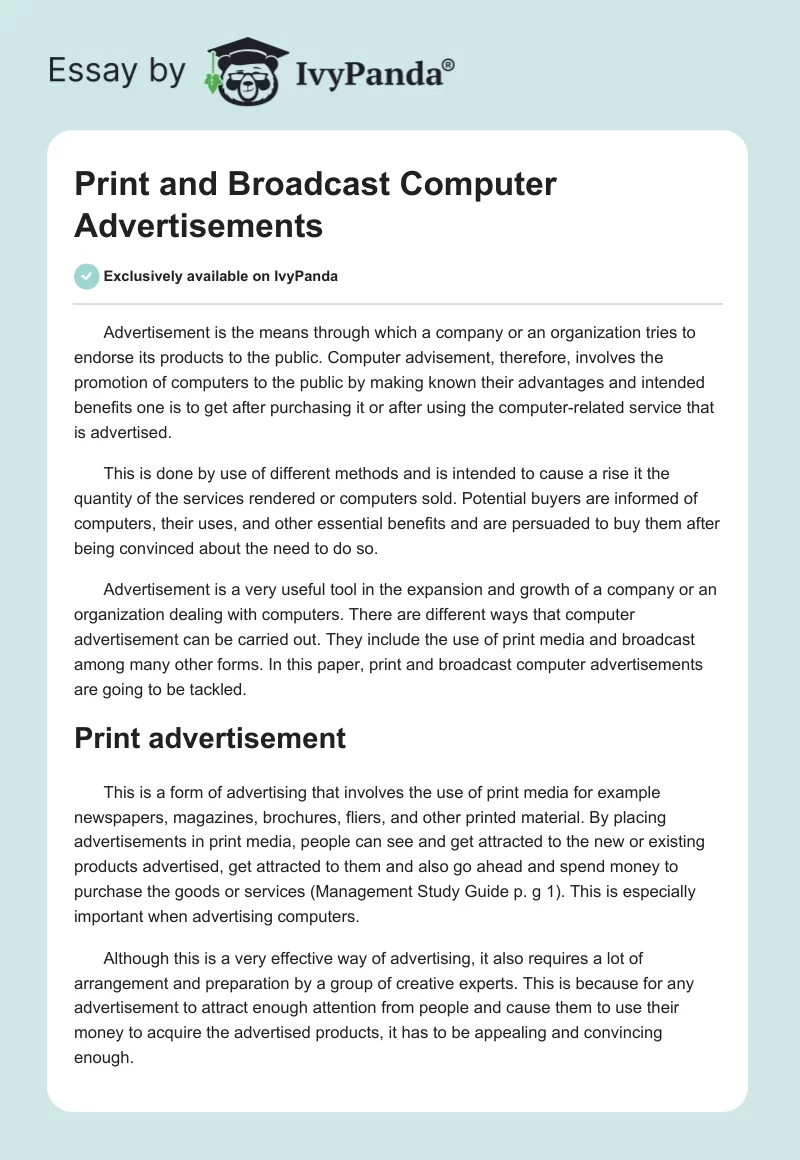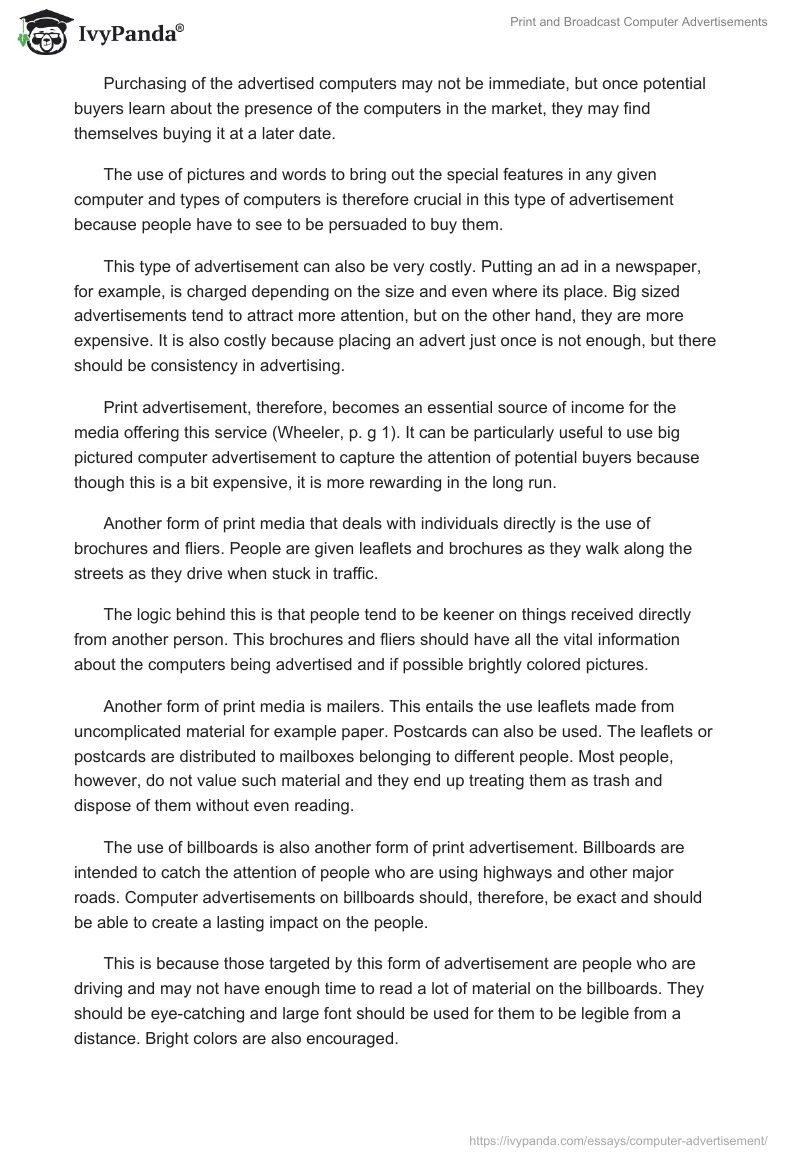Advertisement is the means through which a company or an organization tries to endorse its products to the public. Computer advisement, therefore, involves the promotion of computers to the public by making known their advantages and intended benefits one is to get after purchasing it or after using the computer-related service that is advertised.
This is done by use of different methods and is intended to cause a rise it the quantity of the services rendered or computers sold. Potential buyers are informed of computers, their uses, and other essential benefits and are persuaded to buy them after being convinced about the need to do so.
Advertisement is a very useful tool in the expansion and growth of a company or an organization dealing with computers. There are different ways that computer advertisement can be carried out. They include the use of print media and broadcast among many other forms. In this paper, print and broadcast computer advertisements are going to be tackled.
Print advertisement
This is a form of advertising that involves the use of print media for example newspapers, magazines, brochures, fliers, and other printed material. By placing advertisements in print media, people can see and get attracted to the new or existing products advertised, get attracted to them and also go ahead and spend money to purchase the goods or services (Management Study Guide p. g 1). This is especially important when advertising computers.
Although this is a very effective way of advertising, it also requires a lot of arrangement and preparation by a group of creative experts. This is because for any advertisement to attract enough attention from people and cause them to use their money to acquire the advertised products, it has to be appealing and convincing enough.
Purchasing of the advertised computers may not be immediate, but once potential buyers learn about the presence of the computers in the market, they may find themselves buying it at a later date.
The use of pictures and words to bring out the special features in any given computer and types of computers is therefore crucial in this type of advertisement because people have to see to be persuaded to buy them.
This type of advertisement can also be very costly. Putting an ad in a newspaper, for example, is charged depending on the size and even where its place. Big sized advertisements tend to attract more attention, but on the other hand, they are more expensive. It is also costly because placing an advert just once is not enough, but there should be consistency in advertising.
Print advertisement, therefore, becomes an essential source of income for the media offering this service (Wheeler, p. g 1). It can be particularly useful to use big pictured computer advertisement to capture the attention of potential buyers because though this is a bit expensive, it is more rewarding in the long run.
Another form of print media that deals with individuals directly is the use of brochures and fliers. People are given leaflets and brochures as they walk along the streets as they drive when stuck in traffic.
The logic behind this is that people tend to be keener on things received directly from another person. This brochures and fliers should have all the vital information about the computers being advertised and if possible brightly colored pictures.
Another form of print media is mailers. This entails the use leaflets made from uncomplicated material for example paper. Postcards can also be used. The leaflets or postcards are distributed to mailboxes belonging to different people. Most people, however, do not value such material and they end up treating them as trash and dispose of them without even reading.
The use of billboards is also another form of print advertisement. Billboards are intended to catch the attention of people who are using highways and other major roads. Computer advertisements on billboards should, therefore, be exact and should be able to create a lasting impact on the people.
This is because those targeted by this form of advertisement are people who are driving and may not have enough time to read a lot of material on the billboards. They should be eye-catching and large font should be used for them to be legible from a distance. Bright colors are also encouraged.
The invention of the internet has been a significant threat to print media. This is due to the internet’s ability to reach to a larger population online.
Companies have therefore resulted in the use of the internet to advertise which is more rewarding than using print media. Although there is still significant use of print media, more people prefer to compliment it with other forms of media. This makes advertising more efficient.
Broadcast advertisement
This is a way of passing on the message to the people by use of radio and television. This is one of the most effective methods that can be used by computer companies and organizations to advertise because of its ability to reach many people at once both within the country and abroad.
It is also possible to reach the people targeted mainly by placing the advertisements in particular programs which have large audiences both locally and internationally. This would work especially for computer advertisement because computers are no longer liabilities but a necessity for many people.
Some of the factors that determine the cost of broadcast advertisement include the duration of the ad. Longer duration advertisements cost more than shorter duration ones. The time of the airing of the advertisements is also a factor. According to Management Study Guide (p. g 1), Advertisements aired during peak times would cost more than those aired during other times.
When a broadcast advertisement is used in advertising computers, these two crucial issues should put into consideration: the cost and the time of airing the ad. Most advertisements are given a short duration and therefore when advertising things like computers one should be very precise and use captivating features, for example, pleasant voice and attractive images.
For people computer advertisements, one should also be willing to spend some money to get prime time advertisements which are more likely to get to the target audience and potential customers than adverts aired during regular times (Wheeler, p. g 1).
This is because people tend to pay more attention to programs aired during this time and therefore is better to invest on such time for advertising because it will eventually bring good returns.
This, however, does not mean that people should drain their accounts while trying to advertise computers. Moderation is also essential in maintaining the balance between the money spent on advertisement and that spent on other marketing strategies.
Frequency in advertising is also required to make the products known and appealing to the public. Advertising should be done regularly and consistently for it to be an effective marketing strategy and bring positive returns to the company (Management Study Guide p. g 1). Once is not enough.
Advertising computers using the broadcast method is especially very effective because of the high demand for computers nowadays (Wheeler, p. g 1). Most of the things are being done online; for example, it is possible to shop, learn or sell things online among many other things possible to do online.
Many people are therefore in need of good computers which are able to carry out different functions. It is also essential for people to have confidence in computers one is advertising. This can be possible by one offering accurate information and not just trying to lure people into buying the products for the sake of making a profit.
Use of internet services can also be very effective when advertising computers. There are usually many people accessing the internet at any particular time, and hence, it is a crucial site where potential customers can be found.
Since online buying and selling of products is possible, one can use this as a site for advertising. With consistency in advertising, it is elementary to increase the sale of products for any company and especially the computers which are a commodity in demand for this generation where everything is computerized.
Overview of computer advertisements
Computer advertisement is very imperative for anyone in the computer business. Different methods can be used to advertise, two of which have been discussed in this paper.
If both methods are used conveniently and to complement each other, the possibility of an increase in productivity of the company involved in advertising is very high. This is because for any business to grow, advertisement is an important marketing strategy.
Just like other products need to be advertised to increase awareness to the public, the computers also need to be promoted. Many people interact with computers in their everyday life, and therefore any information about computers is beneficial to many people. With such information, potential customers are well equipped to make informed decisions.
Conclusion
Advertisement is an essential strategy in the marketing of any product. Different methods work for different products. It is vital to know which method works best for the product one intends to market. The computers for example as discussed in this paper can be advertised using print media or broadcast method or one can use both methods depending on how effective each method is when used alone.
Works Cited
Management Study Guide. Classification of Advertising, 2011. Web.
Wheeler, Nikki. Guide to Computer Advertising and Marketing Key Terms. Santa Monica, CA: Business.com, Inc., 2011. Web.


